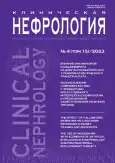Миостатин – важное звено патогенеза белково-энергетической недостаточности у пациентов, получающих лечение программным гемодиализом
- Авторы: Яковенко А.А.1, Есаян А.М.1, Лаврищева Ю.В.2, Румянцев А.Ш.3
-
Учреждения:
- Первый Санкт-Петербургский государственный медицинский университет им. акад. И.П. Павлова
- Национальный медицинский исследовательский центр им. В.А. Алмазова
- Санкт-Петербургский государственный университет
- Выпуск: Том 15, № 4 (2023)
- Страницы: 5-10
- Раздел: Оригинальные статьи
- Статья опубликована: 25.12.2023
- URL: https://journals.eco-vector.com/2075-3594/article/view/630879
- DOI: https://doi.org/10.18565/nephrology.2023.4.5-10
- ID: 630879
Цитировать
Полный текст
Аннотация
Цель исследования: оценить связь между уровнем миостатина в сыворотке крови с показателями белково-энергетической недостаточности (БЭН) у пациентов, получающих лечение программным гемодиализом (ГД).
Материал и методы. Обследованы 645 пациентов, получающих лечение программным ГД, среди них 300 мужчин и 345 женщин в возрасте 56,8±12,8 года. Все больные получали лечение программным ГД в течение 8,4±5,3 года. Оценка нутриционного статуса с целью диагностики БЭН проводили с помощью метода, предложенного ISRNM (International Society of Renal Nutrition and Metabolism). Уровень миостатина в сыворотке крови определяли посредством метода, основанного на принципе конкурентного иммуноферментного анализа с применением моно- и поликлональных антител к миостатину с использованием коммерческого набора «Myostatin ELISA» (Immunodiagnostik, Германия) в соответствии с инструкцией производителя. Референсные значения для миостатина составили 11–44 нг/мл.
Результаты. Распространенность БЭН, определяемая по методу ISRNM, составила 24,9% (160 пациентов). Средние значения миостатина у пациентов без признаков БЭН составили 31,2±16,2 нг/мл, у пациентов с БЭН – 76,7±25,5 нг/мл (p<0,0001). У пациентов с повышенным уровнем миостатина были выявлены статистически значимо более низкие значения показателей БЭН (индекс массы тела, индекс массы скелетной мускулатуры, а также общий белок, альбумин, преальбумин, общий холестерин, трансферрин и число лимфоцитов крови), чем у пациентов с нормальным уровнем миостатина. При этом статистически значимого изменения показателей жировой массы тела в зависимости от уровня миостатина выявлено не было. В ходе исследования достоверной взаимосвязи адекватности дозы ГД (spKt/V) и уровнем миостатина выявлено не было, что подтверждается, в частности, величиной коэффициента корреляции Спирмена (Rs=0,063; р=0,106). При этом не было выявлено связи между уровнем миостатина и длительностью ГД (Rs=0,056; р=0,151).
Заключение. Распространенность БЭН, определяемая по методу ISRNM, среди пациентов, получающих лечение программным ГД, составила 24,9%. Повышение уровня миостатина в сыворотке крови может являться важным патогенетическим звеном в развитии БЭН у пациентов, получающих лечение программным ГД, преимущественно за счет отрицательного влияния на мышечную ткань пациента.
Ключевые слова
Полный текст
Об авторах
Александр Александрович Яковенко
Первый Санкт-Петербургский государственный медицинский университет им. акад. И.П. Павлова
Автор, ответственный за переписку.
Email: leptin-rulit@mail.ru
ORCID iD: 0000-0003-1045-9336
к.м.н., доцент кафедры нефрологии и диализа ФПО ФГБОУ ВО «ПСПбГМУ им. акад. И.П. Павлова» Минздрава РФ
Россия, Санкт-ПетербургАшот Мовсесович Есаян
Первый Санкт-Петербургский государственный медицинский университет им. акад. И.П. Павлова
Email: essaian.ashot@gmail.com
ORCID iD: 0000-0002-7202-3151
д.м.н., профессор, заведующий кафедрой нефрологии и диализа ФПО ФГБОУ ВО «ПСПбГМУ им. акад. И.П. Павлова» Минздрава РФ, главный внештатный нефролог СЗФО РФ
Россия, Санкт-ПетербургЮлия Владимировна Лаврищева
Национальный медицинский исследовательский центр им. В.А. Алмазова
Email: lavrischeva@gmail.com
ORCID iD: 0000-0002-3073-2785
к.м.н., доцент кафедры факультетской терапии с клиникой ФГБУ НМИЦ им. В.А. Алмазова Минздрава РФ
Россия, Санкт-ПетербургАлександр Шаликович Румянцев
Санкт-Петербургский государственный университет
Email: rash.56@mail.ru
ORCID iD: 0000-0002-9455-1043
д.м.н., профессор кафедры факультетской терапии медицинского факультета ФГБОУ ВО «Санкт-Петербургский государственный университет»
Россия, Санкт-ПетербургСписок литературы
- Carrero J.J., Thomas F., Nagy K., et al. Global Prevalence of Protein-Energy Wasting in Kidney Disease: A Meta-analysis of Contemporary Observational Studies From the International Society of Renal Nutrition and Metabolism. J. Ren. Nutr. 2018;28(6):380–92. doi: 10.1053/j.jrn.2018.08.006.
- Kang S.S., Chang J.W., Park Y. Nutritional Status Predicts 10-Year Mortality in Patients with End-Stage Renal Disease on Hemodialysis. Nutrients. 2017;9(4):pii:E399. doi: 10.3390/nu9040399.
- Obi Y., Qader H., Kovesdy C.P., Kalantar-Zadeh K. Latest consensus and update on protein-energy wasting in chronic kidney disease. Curr. Opin. Clin. Nutr. Metab. Care. 2015;18(3):254–62. doi: 10.1097/MCO.0000000000000171.
- Perez Vogt B., Costa Teixeira Caramori J. Are Nutritional Composed Scoring Systems and Protein-Energy Wasting Score Associated With Mortality in Maintenance Hemodialysis Patients? J. Ren. Nutr. 2016;26(3):183–89. doi: 10.1053/j.jrn.2015.11.003.
- Fouque D., Kalantar-Zadeh K., Kopple J., et al. A proposed nomenclature and diagnostic criteria for protein-energy wasting in acute and chronic kidney disease. Kidney Int. 2008;73(4):391–98. doi: 10.1038/sj.ki.5002585.
- Wang X.H., Mitch W.E. Mechanisms of muscle wasting in chronic kidney disease. Nat. Rev. Nephrol. 2014;10(9):504–16. doi: 10.1038/nrneph.2014.112.
- Bataille S., Chauveau P., Fouque D., et al. Myostatin and muscle atrophy during chronic kidney disease. Nephrol. Dial. Transplant. 2021;36(11): 1986–93. doi: 10.1093/ndt/gfaa129.
- Pirruccello-Straub M., Jackson J., Wawersik S., et al. Blocking extracellular activation of myostatin as a strategy for treating muscle wasting. Sci. Rep. 2018;8(1):2292. doi: 10.1038/s41598-018-20524-9.
- Verzola D., Barisione C., Picciotto D., et al. Emerging role of myostatin and its inhibition in the setting of chronic kidney disease. Kidney Int. 2019;95(3): 506–17. doi: 10.1016/j.kint.2018.10.010.
- Yano S., Nagai A., Isomura M., et al. Relationship between blood myostatin levels and kidney function: Shimane CoHRE study. PloS One. 2015;10(10):e0141035. Doi: 10/1371/jour.al.pone.0141035.
- Esposito P., Picciotto D., Battaglia Y., et al. Myostatin: Basic biology to clinical application. Adv. Clin. Chem. 2022;106:181–234. doi: 10.1016/bs.acc.2021.09.006.
Дополнительные файлы





